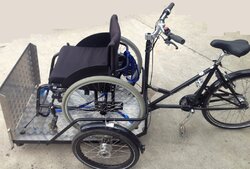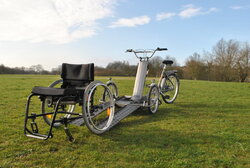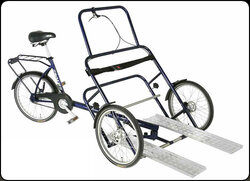Ok, so I should declare a vested interest in this thread - I sell Nihola Flex wheelchair transporters (amongst other things) for a living. And I've already communicated with the OP on the subject of a wheelchair transporter for her kid's school.
But this is as good a venue as any for a discussion of the pros and cons of the various models.
Wheelchair transporters are essential in our work. Our stated aim as a Community Interest Company is to get everyone on a bike, whatever their abilities. A WC transporter allows people with a whole range of profound physical disabilities to participate in cycling.
I know of maybe seven or eight different manufacturers who make wheelchair transporters - many of which are available in the UK. We can offer at least four different models including these;
Nihola Flex:

Nijland (pronounced ny-land) Transporter:

ROAM Traveler:

We could, if we chose, also sell one from Tandemservis (cz), and our competitors sell models from Van Raam, Draisin, Lightfoot .... etc, etc and of course the Christiania pictured above which is about the cheapest of the lot. We're very familiar with what's available as we've sold pre-owned examples of almost all of them via our refurbished bike program. Out of all of the different models available to us we choose to sell the Nihola Flex.
So what sets them all apart? The biggest practical difference is in the steering. Almost all of the wheelchair transporters on the market (and including the Nijland and the ROAM above) use a steering mechanism which is indistinguishable from a traditional Ice Cream trike, factory or cargo trike. This uses a single steering pivot located under the load bay floor and slightly ahead of the front axle. It requires the operator to turn the whole front axle, load bay
and passenger with the bars to initiate a turn. It makes for very heavy steering and it also delivers steering which can be unduly influenced by bumps (unless fitted with a damper) and by road camber. Another issue with this basic horse-cart style steering is that it takes up a lot of space directly underneath the cargo bay floor. Raising the floor raises the centre of gravity of the whole rig -
and - makes the access ramp(s) steeper and/or longer.
The Nihola Flex uses Ackermann steering geometry (like every other twin-front-wheel vee-hicle on the road). It also has 'centre point' geometry which isolates the steering from external bump and brake force feedback. So it handles better and has a lower centre of gravity (so it handles better) and it's easier to get the passenger aboard. It's based on the cargo trike that Nihola designed for the use of the Danish postal service. So in the strength rating terms that we use for bikes and parts this isn't 'solo' rated, nor is it 'tandem' rated - it's '
cargo' rated. Designed to be used every day - all day and in all conditions. The bicycling equivalent of an HGV. It's so well made that we sell these into school playgrounds with 100% confidence that they'll not suffer any warranty issues. And that strength doesn't come at the cost of rideability. What everyone says after their first ride on the Flex is that it rides amazingly easily. It's well designed and uses high quality components and tubing to keep the weight down without compromising strength. And it's geared right, so it's easy to pedal.
We really did our research on this sector before we made the decision to offer the Flex. It's lighter, handles better and easier to use than anything else available. We're convinced that it's better than everything else out there in terms of performance. It's not the cheapest but it's far from being the most expensive. What I often say to people is that we 'invite any comparison'. It kicks all of the others asses.

 FFS have a look at the Kentex 20 inch wheel model (similar to my 24 inch wheel one) I managed to build mine for under a grand with an electric front wheel kit as well.
FFS have a look at the Kentex 20 inch wheel model (similar to my 24 inch wheel one) I managed to build mine for under a grand with an electric front wheel kit as well.




